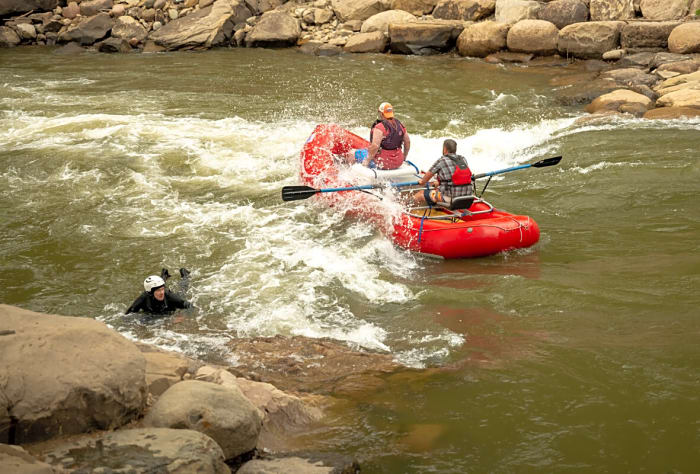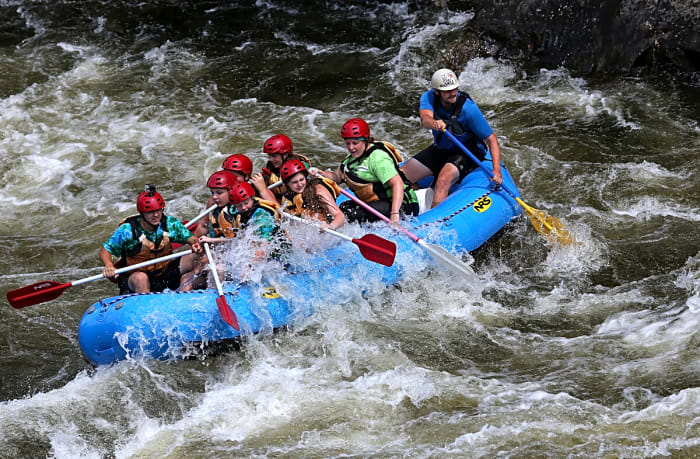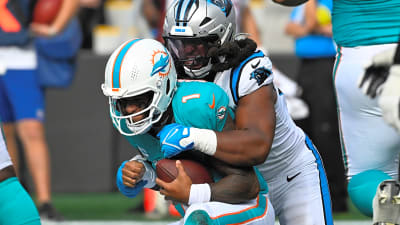As skiers, we spend all winter looking at the forecast, keeping track of how many inches of snow our mountain has gotten, where the snowpack lies in terms of annual average, and so on. But when the mountains warm up and the snow starts to melt, where does it all go? The short answer is, it depends, but a good chunk of it melts into nearby rivers and streams. Oftentimes, where there are big mountains, there are also steep rivers, and when all that runoff hits them, it makes for my personal favorite way to enjoy snowmelt: river running.
Many ski towns are home to at least a few commercial whitewater rafting outfitters, which is by far the easiest and most approachable way to start river running. Lots of these outfitters have operating permits on several rivers and sections so you can choose the adventure that best suits your skill and comfort level. If you're super intrigued after your first time rafting, a lot of these outfitters and/or towns also have schools where you can take a lesson in whitewater kayaking and learn the basics of paddling your own craft down these rivers.
Water levels are often much higher (and colder!) in the spring, which usually means bigger, more challenging, faster-moving whitewater. As there's less and less snow to feed into rivers, the water levels drop, which can mean there are more technical moves to be made, but the features aren't quite as big. A company can help you decide what the best time to run a certain section is, but keep that in mind as you're planning a trip!
Here are a few ski towns that have some of the best whitewater nearby, so you can keep enjoying snow in its liquid form after the lifts stop running.
Want to keep up with the best stories and photos in skiing? Subscribe to the new Powder To The People newsletter for weekly updates.
1. Hood River, OR
The Columbia River Gorge is home to some of the best whitewater on the planet. Although mostly accessed from the Washington side of the bridge, runoff from the surrounding mountains ends up in the White Salmon, Wind, Little White Salmon, Klickitat, and Hood rivers.
While the Little White Salmon is one of the most legendary stretches of whitewater in the world, it takes an expert kayaker to navigate its Class V waters and isn't run commercially. The rest, however, are run commercially by a handful of outfitters in the area and have everything from mellow Class II floats on the Lower White Salmon to launching off the highest commercially run waterfall in the U.S., Husum Falls on the Middle White Salmon, to technical Class IV and V whitewater on the Orletta and Farmlands sections.
These rivers also travel through old lava tubes formed by Mt. Adams and Hood and provide a really cool look into the area's geology. If you're planning a spring or summer ski trip to Mt. Hood and looking for another activity, don't miss the whitewater in the area.
2. McCall, ID
As you drive north to McCall from Boise, ID, on Highway 55, take a peek over the guard rail (but only if you're not driving, 55 is dangerous!) at the North Fork of the Payette River; one of the most famous and challenging sections of whitewater in the world. Just down the hill from Tamarack is some of the country's best whitewater! While most of the North Fork doesn't get run commercially due to its difficulty, the Cabarton section does and is a fun, splashy Class III section of whitewater.
The South Fork and main Payette rivers are also super popular for rafting and have several options. The South Fork Payette has two main sections—the Canyon and Staircase. The Canyon features a series of pool drop Class IV rapids that travel deep into a beautiful river canyon. You can also stop at a natural hot springs right on the river before your guide lines your boat around the formidable Big Falls.
Further downstream, the Staircase section offers another action-packed Class IV section of whitewater and is one of my personal favorite sections of whitewater. The main Payette is a bit mellower than the South Fork but still has fun rapids and big hits like Go Left and Mix Master.
If you're looking to dip your toe into the world of multi-day rafting, northwest of McCall is the Salmon River. The Middle Fork, Main, and Lower Salmon are three of the best and most coveted multi-day raft trips in the world. All three feature stunning river canyons, incredible views, and super fun whitewater.
3. Jackson, WY
Where does all that snowmelt from the legendary deep pow days in the Tetons go? The short answer is into the Snake River. One of the largest tributaries to the Columbia River and fed by several other major river systems in the western US, the Snake is not only home to some fantastic whitewater, but is also a highly important waterway. Just south of the town of Jackson is one of the most famous (and fun!) stretches of the Snake through the Alpine Canyon.
Rapids like Lunch Counter, which is also popular amongst river surfers, Big Kahuna, Double Draw, and Ropes make for a fun and exciting stretch of Class III/III+ whitewater. At high water, the waves in the Canyon get massive, so it's not for the faint of heart or weak paddler. If you're looking for a more mellow, scenic trip, you can also float from Moose to the Wilson Bridge through Grand Teton National Park. Keep your eyes out for moose, bald eagles, otters, and many other types of wildlife if you do!
4. Aspen, CO
While you might have to drive a little from Aspen to actually get to the put-in, it's centrally located near some of Colorado's best whitewater. Closest to town is the Roaring Fork River, which has a scenic Class II float, a splashy Class III section, and the technical and full-on Class IV Slaughterhouse section. Up the road from Aspen, the Roaring Fork River flows into the Colorado River just below the famous Shoshone Rapids section. Filled with some of the best Class III rapids in the state, like Maneater and China Wall, the Shoshone stretch is pretty much guaranteed fun.
A bit further from Aspen is the town of Buena Vista and the Arkansas River. The Arkansas is a favorite of many boaters, and for good reason! From top to bottom, the river has something to offer for just about every skill level and type of adventure. The Pine Creek section offers challenging Class V rapids before flowing into the more approachable but still exciting and technical Class IV Numbers section.
The Numbers section features six numbered rapids varying in length and difficulty (#2 and #5 are my favorites!) before dumping into the more mellow but still splashy Class III Fractions section. Down river a ways is one of the most famous stretches of whitewater in Colorado, Brown's Canyon. Depending on the water level, Brown's Canyon has everything from spicy Class IV to splashy Class III and is one of the most fun and scenic stretches of the Arkansas River.

5. Durango, CO
Not far from Silverton, the Animas River runs right through downtown Durango and offers some of the best whitewater in Colorado. The Upper Animas is considered one of the most difficult commercially run rivers in the US due to its technical and dangerous Class IV and V rapids.
For those looking for a mellower float down the Animas, the lower Animas is home to long, fun stretches of Class I-III whitewater, suitable for paddlers of all ages. Just up the road, near Telluride, the San Miguel River winds through a beautiful sandstone canyon and has plenty of splashy class III fun to offer as well.

6. Charlemont, MA
While the southeast is more known for its whitewater than the northeast, there's still plenty of steep, New England creeks to be found near some of your favorite ski towns. Near Berkshire East, the Deerfield River has several sections of different whitewater, the most popular being the Class II Zoar Gap.
For those looking for a bit more excitement, the Monroe Bridge Dryway on the Deerfield also offers spicy Class IV whitewater. Further north, near Stratton and Mt. Snow, is the West River, which features Class III and IV rapids from the runoff of some of Vermont's best skiing.
Bonus: Salt Lake City, UT
While there isn't much water at all near Salt Lake City, if you go about three hours east or four hours south, you can hit some amazing rivers. East of Salt Lake on the border of Colorado and Utah is Dinosaur National Monument, where the Green and Yampa rivers run through deep desert canyons and meet in Echo Park.
Four or five day raft trips through Dinosaur National Monument are the best way to experience the area and see some beautiful and historically important rivers and landmarks. Runoff from Steamboat goes pretty much right into the Yampa, which flows through downtown Steamboat.
South of Salt Lake a few hours is outdoor recreation hotspot Moab. From Moab, you can float a mellow day stretch on the Colorado, or embark on a multi-day trip through the massive desert rapids in Cataract or Westwater Canyons on the Colorado River.
More must-reads:
- Rob Thomson makes another costly decision during NLDS Game 4
- LeBron James injury will snap mind-blowing trend
- The '100-rushing-yard games by NFL QBs' quiz
Breaking News
Trending News
Customize Your Newsletter
 +
+
Get the latest news and rumors, customized to your favorite sports and teams. Emailed daily. Always free!








